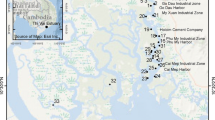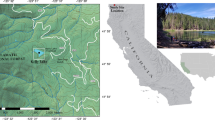Abstract
Shallow ponds in southeast England are often eutrophic with high phosphorus concentrations. The aim of this study was to develop a diatom-phosphorus ‘transfer function’ to enable past phosphorus levels in such waters to be inferred from the sediment record. A water chemistry survey of 123 randomly chosen, shallow, artificial ponds in southeast England was carried out. Principal components analysis (PCA) revealed that phosphorus was an important environmental variable. A subset of 31 sites was selected along a total phosphorus (TP) gradient (winter TP range 7–1123 µg 1−1), in order to explore the relationship between the surface-sediment diatom assemblages and the contemporary water chemistry using canonical correspondence analysis (CCA). Annual mean TP was the most significant variable in explaining the variance in the diatom species data.
Weighted averaging (WA) regression and calibration techniques were used to generate a transfer function, enabling annual mean TP (range 25–646 tig 1−1) to be inferred from the diatom species TP optima of 102 common taxa in the dataset (r 2 = 0.79; RMSE = 0.161; RMSE(boot) = 0.279; n = 30). The model was applied to fossil diatom assemblages in a sediment core from Marsworth Reservoir, Hertfordshire, a Site of Special Scientific Interest (SSSI), with currently high TP levels of 476 µg 1−1 to reconstruct past epilimnetic annual mean TP concentrations.
The study shows that artificial, shallow waters can be suitable for palaeolimnological research and that it is possible to reliably infer lake water TP using the WA technique, across a large range of phosphorus concentrations. This method has the potential to provide limnologists, conservationists and water quality managers with an estimate of pre-enrichment phosphorus concentrations and an indication of the onset and development of eutrophication at a site. This information is essential for lake management strategies and restoration programmes.
Access this chapter
Tax calculation will be finalised at checkout
Purchases are for personal use only
Preview
Unable to display preview. Download preview PDF.
Similar content being viewed by others
References
Agbeti, M. 1992. The relationship between diatom assemblages and trophic variables: a comparison of old and new approaches. Can. J. Fish. aquat. Sci. 49: 1171–1175.
Agbeti, M. & M. Dickman, 1989. Use of lake fossil diatom assemblages to determine historical changes in trophic status. Can. J. Fish. aquat. Sci. 46: 1013–1021.
Anderson, N. J., 1989. A whole-basin diatom accumulation rate for a small eutrophic lake in Northern Ireland and its palaeoecological implications. J. Ecol. 77: 926–946.
Anderson, N. J., 1990. The biostratigraphy and taxonomy of small Stephanodiscus and Cyclostephanos species ( Bacillariophyceae) in a eutrophic lake, and their ecological implications. Br. phycol. J. 25: 217–235.
Anderson, N. J., 1993. Inferring diatom palaeoproduction and lake trophic status from fossil diatom assemblages. Proc. Calif. Acad. Sci., in press.
Anderson, N. J., B. Rippey & C. E. Gibson, 1993. A comparison of sedimentary and diatom-inferred phosphorus profiles: implications for defining pre-disturbance nutrient conditions. Hydrobiologia 253/Dev. Hydrobiol. 84: 357–366.
Anderson, N. J., B. Rippey & A. C. Stevenson, 1990. Diatom assemblage changes in a eutrophic lake following point source nutrient re-direction: a palaeolimnological approach. Freshwat. Biol. 23: 205–217.
Appleby, P. G. & F. Oldfield, 1978. The calculation of 21°Pb dates assuming a constant rate of supply of unsupported 210Pb to the sediment. Catena 5: 1–8.
Appleby, P. G., P. Nolan, D. W. Gifford, M. J. Godfrey, F. Oldfield, N. J. Anderson & R. W. Battarbee, 1986. 210Pb dating by low background gamma counting. Hydrobiologia 141/Dev. Hydrobiol. 36: 21–27.
Bailey-Watts, A. E., A. Kirika, L. May & D. H. Jones, 1990. Changes in phytoplankton over various time scales in a shallow, eutrophic lake: the Loch Leven experience with special reference to the influence of flushing rate. Freshwat. Biol. 23: 85–111.
Battarbee, R. W., 1978. Observations on the recent history of Lough Neagh and its drainage basin. Phil. Trans. r. Soc., Lond. 281: 303–345.
Battarbee, R. W., 1984. Diatom analysis and the acidification of lakes. Phil. Trans. r. Soc., Lond. 305: 451–477.
Battarbee, R. W., 1986. Diatom analysis. In B. E. Berglund (ed.), Handbook of Holocene palaeoecology and palaeohydrology. Wiley, Chichester: 527–570.
Battarbee, R. W. & M. J. Kneen, 1982. The use of electronically counted microspheres in absolute diatom analysis. Limnol. Oceanogr. 27: 184–188.
Bennion, H., (1993). A diatom-phosphorus transfer function for eutrophic ponds in south-east England. Unpublished PhD, University College London.
Birks, H. J. B., J. M. Line, S. Juggins, A. C. Stevenson & C. J. F. Ter Braak, 1990. Diatoms and pH reconstruction. Phil. Trans. r. Soc., Lond., series B 327: 263–278.
Bradbury, J. P., 1975. Diatom stratigraphy and human settlement in Minnesota. Geol. Soc. Am. Special Paper 171: 74 pp.
Camburn, K. E., J. C. Kingston & D. F. Charles (eds), 1984–1986. PIRLA Diatom Iconograph. Unpublished Report Series, Report 3. Indiana University, Bloomington, USA.
Canter, H. M. & J. W. G. Lund, 1953. Studies on plankton parasites II. The parasitism of diatoms with special reference to lakes in the English Lake District. Trans. br. mycol. Soc. 36: 13–37.
Cleve-Euler, A., 1951–1955. Die diatomeen von Schweden und Finnland. Kungl. Svenska Vet. Handlinger, Almqvist & Wiksell, Stockholm.
Department of the Environment, National Water Council, 1982. Methods for the examination of waters and associated materials: Oxidised nitrogen in waters 1981. HMSO, London: 42–48.
Efron, B., 1982. The jackknife, the bootstrap, and other re-sampling methods. Society for Industrial and Applied Mathematics, CBMS-NSF Monograph 38.
Flower, R. J., 1986. The relationship between surface sediment diatom assemblages and pH in 33 Galloway Lakes: some regression models for reconstructing pH and their application to sediment cores. Hydrobiologia 143/Dev. Hydrobiol. 37: 93–103.
Gibson, C. E., 1984. Sinking rates of planktonic diatoms in an unstratified lake: a comparison of field and laboratory observations. Freshwat. Biol. 14: 631–638.
Hâkansson, H., 1986. A taxonomic reappraisal of some Stephanodiscus species ( Bacillariophyta ). Br. phycol. J. 21: 25–37.
Hâkansson, H. & H. Kling, 1990. The current status of some very small freshwater diatoms of the genera Stephanodiscus and Cyclostephanos. Diatom Research 5: 273–287.
Hall, R. I. & J. P. Smol, 1992. A weighted-averaging regression and calibration model for inferring total phosphorus concentration from diatoms in British Columbia (Canada) lakes. Freshwat. Biol. 27: 417–434.
Harriman, R., E. Gillespie, D. King, A. W. Watt, A. E. G. Christie, A. A. Cowan & T. Edwards, 1990. Short-term ionic responses as indicators of hydrochemical processes in the Allt A’ Mharcaidh catchment, Western Cairngorms, Scotland. J. Hydrology 116: 267–285.
Hartley, B., 1986. A check-list of the freshwater, brackish and marine diatoms of the British Isles and adjoining coastal waters. J. mar. biol. Ass. U.K. 66: 531–610.
Hustedt, F., 1930–1966. Die Kieselalgen Deutschlands, Österreichs und der Schweiz mit Berücksichtigung der übrigen Länder Europas sowie der angrenzenden Meeresgebiete. Kryptogamen-Flora 7 Vol. 1 (1927–1930), 2 (1937–1959), 3 (1961–1966). Geest and Portig, Leipzig.
Jones, D. K. C., 1981. The Geomorphology of the British Isles: Southeast and Southern England. Methuen, London, 332 pp.
Juggins, S. & C. J. F. ter Braak, 1993. CALIBRATE Version 1. 0. Environmental Change Research Centre, University College London.
Kajak, Z., 1966. Field experiment in studies on benthos density of some Mazurian lakes. Gewässer und Abwässer 41/ 42: 150–158.
Kilham, S. S., 1975. Kinetics of silica-limited growth in the freshwater diatom Asterionella formosa. J. Phycol. 11: 396–399.
Kingston, J. C., H. J. B. Birks, A. J. Uutala, B. F. Cumming &J. P. Smol, 1992. Assessing the trends in fishery resources and lake water aluminium from palaeolimnological analyses of siliceous algae. Can. J. Fish. aquat. Sci. 49: 127–138.
Krammer, K. & H. Lange-Bertalot, 1986. Süsswasserflora von Mitteleuropa. Bacillariophyceae. 1. Teil: Naviculaceae. Gustav Fischer Verlag, Stuttgart, 876 pp.
Line, J. M. & H. J. B. Birks, 1990. WACALIB version 2.1–a computer program to reconstruct environmental variables from fossil diatom assemblages by weighted averaging. J. Palaeolimnol. 3: 170–173.
Linc, J. M., C. J. F. ter Braak & H. J. B. Birks, 1991. WACALIB version 3.0, unpublished program.
Livingstone, D. A., 1955. A lightweight piston sampler for lake deposits. Ecology 36: 137–139.
Lund, J. W. G., 1959. Buoyancy in relation to the ecology of freshwater phytoplankton. Br. phycol. Bull. 1: 1–17.
Marker, A. F. H., 1972. The use of acetone and methanol in the estimation of chlorophyll in the presence of phaeophytin. Freshwat. Biol. 2: 361–385.
Martens, H. & T. Naes, 1989. Methods for calibration. In Martens, H. & T. Naes, Multivariate Calibration. Wiley & Sons, Chichester: 73–85.
Murphy, J. & J. P. Riley, 1962. A modified single-solution method for the determination of phosphate in natural waters. Analyt. chim. Acta 27: 31.
Organisation for Economic Co-operation and Development, OECD., 1982. Eutrophication of waters: monitoring, assessment and control. OECD, Paris: 154 pp.
Patrick, R. & C. Reimer, 1966. The Diatoms of the United States, Vol. 1. Academy of Natural Sciences, Philadelphia, Monograph 3: 1–668.
Patrick, R. & C. Reimer, 1975. The Diatoms of the United States, Vol. 2, Part 1. Academy of Natural Sciences, Philadelphia, Monograph 13: 1–213.
Reynolds, C. S., 1973. The seasonal periodicity of planktonic diatoms in a shallow eutrophic lake. Freshwat. Biol. 3: 89–110.
Smol, J. P., 1992. Paleolimnology: an important tool for effective ecosystem management. Journal of Aquatic Ecosystem Health 1: 49–58.
Sondergaard, M., P. Kristensen & E. Jeppesen, 1992. Phosphorus release from resuspended sediment in the shallow and wind exposed Lake Arreso, Denmark. Hydrobiologia 228: 91–99.
Stevenson, A. C., S. Juggins, H. J. B. Birks, D. S. Anderson. N. J. Anderson, R. W. Battarbee, F. Berge, R. B. Davis, R. J. Flower, E. Y. Haworth, V. J. Jones, J. C. Kingston, A. M. Kreiser, J. M. Line, M. A. R. Munro & I. Renberg, 1991. The Surface Waters Acidification Project Palaeolimnology Programme: Modern Diatom/Lake-water Chemistry Data-set. ENSIS Publishing, London, England.
Stockner, J. G. & W. W. Benson, 1967. The succession of diatom assemblages in the recent sediments of Lake Washington. Limnol. Oceanogr. 12: 513–532.
Stoermer, E. F. & H. Häkansson, 1984. Stephanodiscus par-vus: validation of an enigmatic and widely misconstrued taxon. Nova Hedwigia 39: 497–511.
Stoermer, E. F., H. Hakansson & E. C. Theriot, 1987. Cyclostephanos species newly reported from North America: C. tholìformis sp. nov. and C. costalimbus comb. nov. Br. phycol. J. 22: 349–358.
Strickland, J. D. H. & T. R. Parsons, 1972. A Practical Handbook of Seawater Analyses. Bull. Fish. Res. Bd. Can. 167, second edition.
ter Braak, C. J. F., 1987a. The analysis of vegetation-environment relationships by canonical correspondence analysis. Vegetatio 69: 69–77.
ter Braak, C. J. F., 1987b. CANOCO - a FORTRAN program for canonical community ordination by [partial] [detrended] [canonical] correspondence analysis, principal components analysis and redundancy analysis (version 2.1). TNO Institute of Applied Computer Science, Wageningen, 95 pp.
ter Braak, C. J. F., 1990. Update notes: CANOCO version 3.10. Agricultural Mathematics Group, Wageningen, 35 pp.
ter Braak, C. J. F. & H. van Dam, 1989. Inferring pH from diatoms: a comparison of old and new calibration methods. Hydrobiologia 178: 209–223.
Theriot, E. C., E. F. Stoermer & H. Häkansson, 1987. Taxonomic interpretation of the rimoportula of freshwater genera in the centric diatom family Thalassiosiraceae. Diatom Research 2: 251–265.
Vanni, M. J. & J. Temte, 1990. Seasonal patterns of grazing and nutrient limitation of phytoplankton in a eutrophic lake. Limnol. Oceanogr. 35: 697–709.
Whitmore, T. J., 1989. Florida diatom assemblages as indicators of lake trophic state and pH. Limnol. Oceanogr. 34: 882–895.
Author information
Authors and Affiliations
Editor information
Rights and permissions
Copyright information
© 1994 Springer Science+Business Media Dordrecht
About this chapter
Cite this chapter
Bennion, H. (1994). A diatom-phosphorus transfer function for shallow, eutrophic ponds in southeast England. In: Mortensen, E., Jeppesen, E., Søndergaard, M., Nielsen, L.K. (eds) Nutrient Dynamics and Biological Structure in Shallow Freshwater and Brackish Lakes. Developments in Hydrobiology, vol 94. Springer, Dordrecht. https://doi.org/10.1007/978-94-017-2460-9_35
Download citation
DOI: https://doi.org/10.1007/978-94-017-2460-9_35
Publisher Name: Springer, Dordrecht
Print ISBN: 978-90-481-4360-3
Online ISBN: 978-94-017-2460-9
eBook Packages: Springer Book Archive




